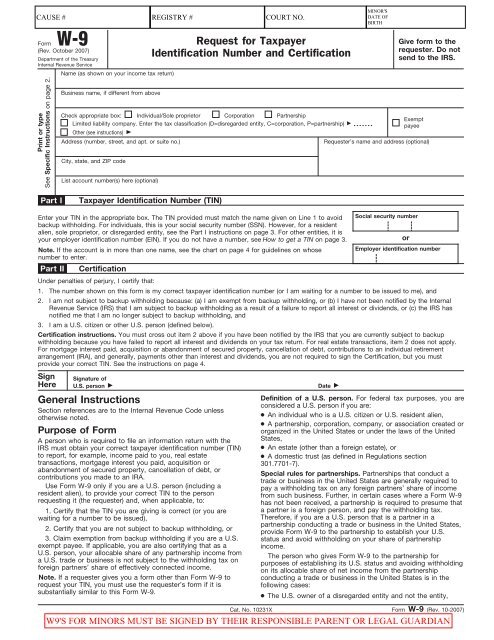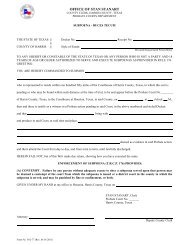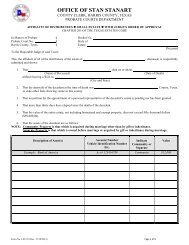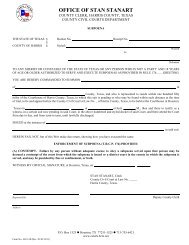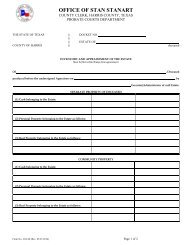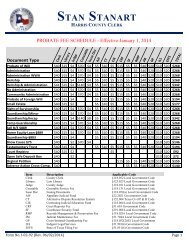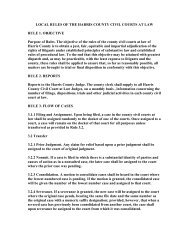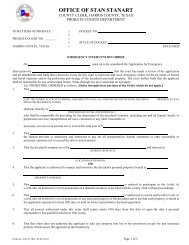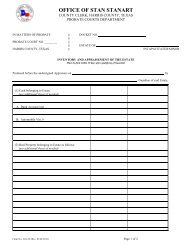W-9 IRS Form
W-9 IRS Form
W-9 IRS Form
Create successful ePaper yourself
Turn your PDF publications into a flip-book with our unique Google optimized e-Paper software.
<strong>Form</strong> W-9 Request for Taxpayer(Rev. October 2007)Identification Number and CertificationDepartment of the TreasuryInternal Revenue ServiceName (as shown on your income tax return)Give form to therequester. Do notsend to the <strong>IRS</strong>.Print or typeSee Specific Instructions on page 2.Business name, if different from aboveCheck appropriate box: Individual/Sole proprietor Corporation PartnershipLimited liability company. Enter the tax classification (D=disregarded entity, C=corporation, P=partnership) Other (see instructions) Address (number, street, and apt. or suite no.)City, state, and ZIP codeList account number(s) here (optional)ExemptpayeeRequester’s name and address (optional)Part ITaxpayer Identification Number (TIN)Enter your TIN in the appropriate box. The TIN provided must match the name given on Line 1 to avoidbackup withholding. For individuals, this is your social security number (SSN). However, for a residentalien, sole proprietor, or disregarded entity, see the Part I instructions on page 3. For other entities, it isyour employer identification number (EIN). If you do not have a number, see How to get a TIN on page 3.Note. If the account is in more than one name, see the chart on page 4 for guidelines on whosenumber to enter.Part IICertificationUnder penalties of perjury, I certify that:Social security numberorEmployer identification number1. The number shown on this form is my correct taxpayer identification number (or I am waiting for a number to be issued to me), and2.I am not subject to backup withholding because: (a) I am exempt from backup withholding, or (b) I have not been notified by the InternalRevenue Service (<strong>IRS</strong>) that I am subject to backup withholding as a result of a failure to report all interest or dividends, or (c) the <strong>IRS</strong> hasnotified me that I am no longer subject to backup withholding, and3. I am a U.S. citizen or other U.S. person (defined below).Certification instructions. You must cross out item 2 above if you have been notified by the <strong>IRS</strong> that you are currently subject to backupwithholding because you have failed to report all interest and dividends on your tax return. For real estate transactions, item 2 does not apply.For mortgage interest paid, acquisition or abandonment of secured property, cancellation of debt, contributions to an individual retirementarrangement (IRA), and generally, payments other than interest and dividends, you are not required to sign the Certification, but you mustprovide your correct TIN. See the instructions on page 4.SignHereSignature ofU.S. person General InstructionsSection references are to the Internal Revenue Code unlessotherwise noted.Purpose of <strong>Form</strong>A person who is required to file an information return with the<strong>IRS</strong> must obtain your correct taxpayer identification number (TIN)to report, for example, income paid to you, real estatetransactions, mortgage interest you paid, acquisition orabandonment of secured property, cancellation of debt, orcontributions you made to an IRA.Use <strong>Form</strong> W-9 only if you are a U.S. person (including aresident alien), to provide your correct TIN to the personrequesting it (the requester) and, when applicable, to:1. Certify that the TIN you are giving is correct (or you arewaiting for a number to be issued),2. Certify that you are not subject to backup withholding, or3. Claim exemption from backup withholding if you are a U.S.exempt payee. If applicable, you are also certifying that as aU.S. person, your allocable share of any partnership income froma U.S. trade or business is not subject to the withholding tax onforeign partners’ share of effectively connected income.Note. If a requester gives you a form other than <strong>Form</strong> W-9 torequest your TIN, you must use the requester’s form if it issubstantially similar to this <strong>Form</strong> W-9.Date Definition of a U.S. person. For federal tax purposes, you areconsidered a U.S. person if you are:● An individual who is a U.S. citizen or U.S. resident alien,● A partnership, corporation, company, or association created ororganized in the United States or under the laws of the UnitedStates,● An estate (other than a foreign estate), or● A domestic trust (as defined in Regulations section301.7701-7).Special rules for partnerships. Partnerships that conduct atrade or business in the United States are generally required topay a withholding tax on any foreign partners’ share of incomefrom such business. Further, in certain cases where a <strong>Form</strong> W-9has not been received, a partnership is required to presume thata partner is a foreign person, and pay the withholding tax.Therefore, if you are a U.S. person that is a partner in apartnership conducting a trade or business in the United States,provide <strong>Form</strong> W-9 to the partnership to establish your U.S.status and avoid withholding on your share of partnershipincome.The person who gives <strong>Form</strong> W-9 to the partnership forpurposes of establishing its U.S. status and avoiding withholdingon its allocable share of net income from the partnershipconducting a trade or business in the United States is in thefollowing cases:● The U.S. owner of a disregarded entity and not the entity,Cat. No. 10231X<strong>Form</strong> W-9 (Rev. 10-2007)
<strong>Form</strong> W-9 (Rev. 10-2007) Page 3Generally, individuals (including sole proprietors) are not exemptfrom backup withholding. Corporations are exempt from backupwithholding for certain payments, such as interest and dividends.Note. If you are exempt from backup withholding, you shouldstill complete this form to avoid possible erroneous backupwithholding.The following payees are exempt from backup withholding:1. An organization exempt from tax under section 501(a), anyIRA, or a custodial account under section 403(b)(7) if the accountsatisfies the requirements of section 401(f)(2),2. The United States or any of its agencies orinstrumentalities,3. A state, the District of Columbia, a possession of the UnitedStates, or any of their political subdivisions or instrumentalities,4. A foreign government or any of its political subdivisions,agencies, or instrumentalities, or5. An international organization or any of its agencies orinstrumentalities.Other payees that may be exempt from backup withholdinginclude:6. A corporation,7. A foreign central bank of issue,8. A dealer in securities or commodities required to register inthe United States, the District of Columbia, or a possession ofthe United States,9. A futures commission merchant registered with theCommodity Futures Trading Commission,10. A real estate investment trust,11. An entity registered at all times during the tax year underthe Investment Company Act of 1940,12. A common trust fund operated by a bank under section584(a),13. A financial institution,14. A middleman known in the investment community as anominee or custodian, or15. A trust exempt from tax under section 664 or described insection 4947.The chart below shows types of payments that may beexempt from backup withholding. The chart applies to theexempt payees listed above, 1 through 15.IF the payment is for . . .Interest and dividend paymentsBroker transactionsBarter exchange transactionsand patronage dividendsPayments over $600 requiredto be reported and direct1sales over $5,0001THEN the payment is exemptfor . . .All exempt payees exceptfor 9Exempt payees 1 through 13.Also, a person registered underthe Investment Advisers Act of1940 who regularly acts as abrokerExempt payees 1 through 5Generally, exempt payees21 through 7See <strong>Form</strong> 1099-MISC, Miscellaneous Income, and its instructions.2However, the following payments made to a corporation (including grossproceeds paid to an attorney under section 6045(f), even if the attorney is acorporation) and reportable on <strong>Form</strong> 1099-MISC are not exempt frombackup withholding: medical and health care payments, attorneys’ fees, andpayments for services paid by a federal executive agency.Part I. Taxpayer IdentificationNumber (TIN)Enter your TIN in the appropriate box. If you are a residentalien and you do not have and are not eligible to get an SSN,your TIN is your <strong>IRS</strong> individual taxpayer identification number(ITIN). Enter it in the social security number box. If you do nothave an ITIN, see How to get a TIN below.If you are a sole proprietor and you have an EIN, you mayenter either your SSN or EIN. However, the <strong>IRS</strong> prefers that youuse your SSN.If you are a single-member LLC that is disregarded as anentity separate from its owner (see Limited liability company(LLC) on page 2), enter the owner’s SSN (or EIN, if the ownerhas one). Do not enter the disregarded entity’s EIN. If the LLC isclassified as a corporation or partnership, enter the entity’s EIN.Note. See the chart on page 4 for further clarification of nameand TIN combinations.How to get a TIN. If you do not have a TIN, apply for oneimmediately. To apply for an SSN, get <strong>Form</strong> SS-5, Applicationfor a Social Security Card, from your local Social SecurityAdministration office or get this form online at www.ssa.gov. Youmay also get this form by calling 1-800-772-1213. Use <strong>Form</strong>W-7, Application for <strong>IRS</strong> Individual Taxpayer IdentificationNumber, to apply for an ITIN, or <strong>Form</strong> SS-4, Application forEmployer Identification Number, to apply for an EIN. You canapply for an EIN online by accessing the <strong>IRS</strong> website atwww.irs.gov/businesses and clicking on Employer IdentificationNumber (EIN) under Starting a Business. You can get <strong>Form</strong>s W-7and SS-4 from the <strong>IRS</strong> by visiting www.irs.gov or by calling1-800-TAX-FORM (1-800-829-3676).If you are asked to complete <strong>Form</strong> W-9 but do not have a TIN,write “Applied For” in the space for the TIN, sign and date theform, and give it to the requester. For interest and dividendpayments, and certain payments made with respect to readilytradable instruments, generally you will have 60 days to get aTIN and give it to the requester before you are subject to backupwithholding on payments. The 60-day rule does not apply toother types of payments. You will be subject to backupwithholding on all such payments until you provide your TIN tothe requester.Note. Entering “Applied For” means that you have alreadyapplied for a TIN or that you intend to apply for one soon.Caution: A disregarded domestic entity that has a foreign ownermust use the appropriate <strong>Form</strong> W-8.Part II. CertificationTo establish to the withholding agent that you are a U.S. person,or resident alien, sign <strong>Form</strong> W-9. You may be requested to signby the withholding agent even if items 1, 4, and 5 below indicateotherwise.For a joint account, only the person whose TIN is shown inPart I should sign (when required). Exempt payees, see ExemptPayee on page 2.Signature requirements. Complete the certification as indicatedin 1 through 5 below.1. Interest, dividend, and barter exchange accountsopened before 1984 and broker accounts considered activeduring 1983. You must give your correct TIN, but you do nothave to sign the certification.2. Interest, dividend, broker, and barter exchangeaccounts opened after 1983 and broker accounts consideredinactive during 1983. You must sign the certification or backupwithholding will apply. If you are subject to backup withholdingand you are merely providing your correct TIN to the requester,you must cross out item 2 in the certification before signing theform.
<strong>Form</strong> W-9 (Rev. 10-2007) Page 43. Real estate transactions. You must sign the certification.You may cross out item 2 of the certification.4. Other payments. You must give your correct TIN, but youdo not have to sign the certification unless you have beennotified that you have previously given an incorrect TIN. “Otherpayments” include payments made in the course of therequester’s trade or business for rents, royalties, goods (otherthan bills for merchandise), medical and health care services(including payments to corporations), payments to anonemployee for services, payments to certain fishing boat crewmembers and fishermen, and gross proceeds paid to attorneys(including payments to corporations).5. Mortgage interest paid by you, acquisition orabandonment of secured property, cancellation of debt,qualified tuition program payments (under section 529), IRA,Coverdell ESA, Archer MSA or HSA contributions ordistributions, and pension distributions. You must give yourcorrect TIN, but you do not have to sign the certification.What Name and Number To Give the RequesterFor this type of account:1. Individual2. Two or more individuals (jointaccount)3. Custodian account of a minor(Uniform Gift to Minors Act)4. a. The usual revocable savingstrust (grantor is also trustee)b. So-called trust account that isnot a legal or valid trust understate law5. Sole proprietorship or disregardedentity owned by an individualFor this type of account:6. Disregarded entity not owned by anindividual7. A valid trust, estate, or pension trust8. Corporate or LLC electingcorporate status on <strong>Form</strong> 88329. Association, club, religious,charitable, educational, or othertax-exempt organization10. Partnership or multi-member LLC11. A broker or registered nominee12. Account with the Department ofAgriculture in the name of a publicentity (such as a state or localgovernment, school district, orprison) that receives agriculturalprogram paymentsGive name and SSN of:The individualThe actual owner of the account or,if combined funds, the first1individual on the accountThe minor 2The grantor-trustee 1The actual owner 1The owner 3The ownerGive name and EIN of:Legal entity 4The corporationThe organizationThe partnershipThe broker or nomineeThe public entity1List first and circle the name of the person whose number you furnish. If only one personon a joint account has an SSN, that person’s number must be furnished.2Circle the minor’s name and furnish the minor’s SSN.3You must show your individual name and you may also enter your business or “DBA”name on the second name line. You may use either your SSN or EIN (if you have one),but the <strong>IRS</strong> encourages you to use your SSN.4List first and circle the name of the trust, estate, or pension trust. (Do not furnish the TINof the personal representative or trustee unless the legal entity itself is not designated inthe account title.) Also see Special rules for partnerships on page 1.Note. If no name is circled when more than one name is listed,the number will be considered to be that of the first name listed.Secure Your Tax Records from Identity TheftIdentity theft occurs when someone uses your personalinformation such as your name, social security number (SSN), orother identifying information, without your permission, to commitfraud or other crimes. An identity thief may use your SSN to geta job or may file a tax return using your SSN to receive a refund.To reduce your risk:● Protect your SSN,● Ensure your employer is protecting your SSN, and● Be careful when choosing a tax preparer.Call the <strong>IRS</strong> at 1-800-829-1040 if you think your identity hasbeen used inappropriately for tax purposes.Victims of identity theft who are experiencing economic harmor a system problem, or are seeking help in resolving taxproblems that have not been resolved through normal channels,may be eligible for Taxpayer Advocate Service (TAS) assistance.You can reach TAS by calling the TAS toll-free case intake lineat 1-877-777-4778 or TTY/TDD 1-800-829-4059.Protect yourself from suspicious emails or phishingschemes. Phishing is the creation and use of email andwebsites designed to mimic legitimate business emails andwebsites. The most common act is sending an email to a userfalsely claiming to be an established legitimate enterprise in anattempt to scam the user into surrendering private informationthat will be used for identity theft.The <strong>IRS</strong> does not initiate contacts with taxpayers via emails.Also, the <strong>IRS</strong> does not request personal detailed informationthrough email or ask taxpayers for the PIN numbers, passwords,or similar secret access information for their credit card, bank, orother financial accounts.If you receive an unsolicited email claiming to be from the <strong>IRS</strong>,forward this message to phishing@irs.gov. You may also reportmisuse of the <strong>IRS</strong> name, logo, or other <strong>IRS</strong> personal property tothe Treasury Inspector General for Tax Administration at1-800-366-4484. You can forward suspicious emails to theFederal Trade Commission at: spam@uce.gov or contact them atwww.consumer.gov/idtheft or 1-877-IDTHEFT(438-4338).Visit the <strong>IRS</strong> website at www.irs.gov to learn more aboutidentity theft and how to reduce your risk.Privacy Act NoticeSection 6109 of the Internal Revenue Code requires you to provide your correct TIN to persons who must file information returns with the <strong>IRS</strong> to report interest,dividends, and certain other income paid to you, mortgage interest you paid, the acquisition or abandonment of secured property, cancellation of debt, orcontributions you made to an IRA, or Archer MSA or HSA. The <strong>IRS</strong> uses the numbers for identification purposes and to help verify the accuracy of your tax return.The <strong>IRS</strong> may also provide this information to the Department of Justice for civil and criminal litigation, and to cities, states, the District of Columbia, and U.S.possessions to carry out their tax laws. We may also disclose this information to other countries under a tax treaty, to federal and state agencies to enforce federalnontax criminal laws, or to federal law enforcement and intelligence agencies to combat terrorism.You must provide your TIN whether or not you are required to file a tax return. Payers must generally withhold 28% of taxable interest, dividend, and certain otherpayments to a payee who does not give a TIN to a payer. Certain penalties may also apply.


